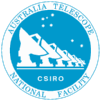Changes between Version 4 and Version 5 of ExplanationOfStages
- Timestamp:
- 09/12/07 11:55:50 (17 years ago)
Legend:
- Unmodified
- Added
- Removed
- Modified
-
ExplanationOfStages
v4 v5 12 12 4. The large number of channels in CABB data and the large data volume will make automated flagging highly desirable, possibly essential. The next stage of work focuses on this area. New heuristics will be needed to remove RFI sources similar to the 128MHz "birdie" that affects current data, and make use of new "bad data" indicator flags in the CABB data files. This work will start as soon as our Stage 1 code is released (Mar 2008) and continue through the early part of the commissioning period (Apr-Jul 2008). Work on new flagging methods employing the auto-correlation data will be pursued in this period as well. Some further work in this area (using data from dedicated RFI monitoring antennae) may be required when the new 1-3GHz receivers are installed (Mar 2009). 13 13 14 Because the autocorrelation data will be routinely available from the CABB correlator, this opens the possibility of using the array as a group of single dishes and doing rapid single-dish mapping of the sky. This is probably best addressed by having the online system write a different format data file from the correlator, since it requires observing methods (on-off scans) quite different to those used in interferometry. As such this would be out of scope for this project. However it is clear that it should be possible to extract the autocorrelations from an interferometer observation and feed them into some single dish package such as [http://www.atnf.csiro.au/computing/software/asap/ ASAP]. Such extraction is in-scope for this project.14 Because the autocorrelation data will be routinely available from the CABB correlator, this opens the possibility of using the array as a group of single dishes and doing rapid single-dish mapping of the sky. This is probably best addressed by having the online system write a different format data file from the correlator, since it requires observing methods (on-off scans) quite different to those used in interferometry. As such this would be out of scope for this project. However it is clearly desirable to be able to extract the autocorrelations from an interferometer observation and feed them into some single dish package such as [http://www.atnf.csiro.au/computing/software/asap/ ASAP]. Such extraction is in-scope for this project. 15 15 16 16
